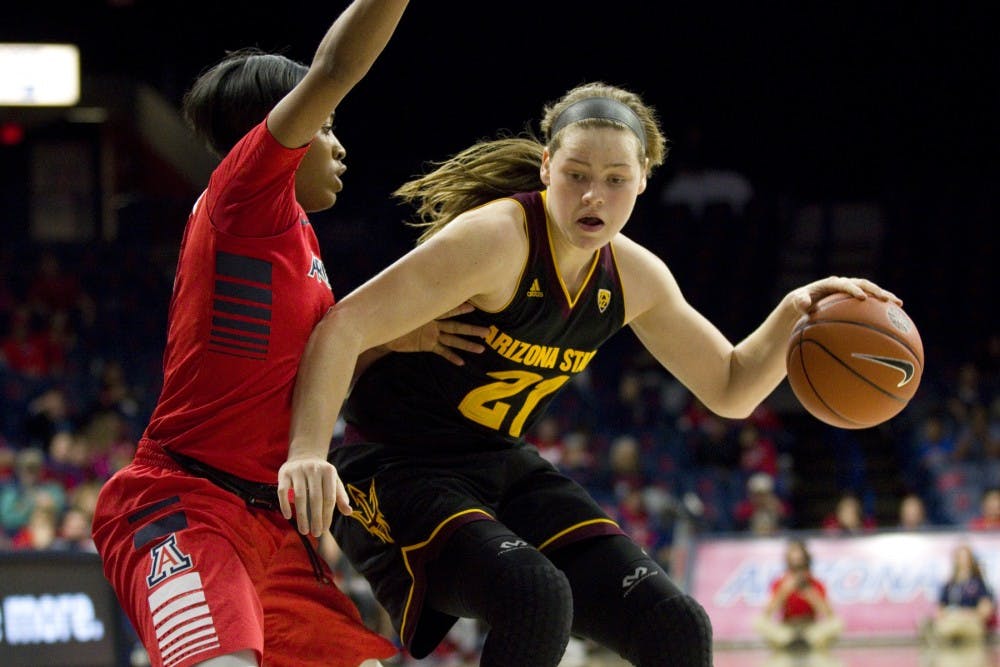Fewer fans, less respect and less money: These are the obstacles that female athletes face in the world because of the way an overwhelming majority of society views and treats women's sports.
In mid-April, former ASU women’s basketball player Sophie Brunner got first-hand experience of professional female sports and the challenges these athletes deal with when she signed with the Phoenix Mercury.
Brunner signed a training camp contract with the Mercury, and if she does well and makes the regular season team, she will most likely receive the rookie minimum contract in the WNBA of $34,500.
This rookie minimum is less than the average teacher's salary in every state and also one-sixteenth of the NBA’s minimum rookie contract of $543,471 in the 2016-17 season.
Because of the lower salary, even if Brunner makes the Mercury team she will play professional basketball overseas during the WNBA offseason to make more money.
The wage gap is a common problem in women’s sports. The U.S. Women’s National Hockey Team and soccer team have been front-runners on pushing for an end to this inequality.
“For no reason other than gender, these women are being paid less,” said silver medalist in women's ice hockey at the 2014 Sochi Winter Olympics and ASU graduate student Lyndsey Fry. “I didn’t get paid anything in my professional career. I got a stipend to live on and that was it.”
While Fry never got paid, the U.S. Women’s National Hockey Team reached an agreement this past March with the USA Hockey’s executive committee that resulted in the women athletes making roughly $70,000 per a player, according to ESPN. This is a huge upgrade from only receiving the $6,000 stipend that the players got while Fry was on the team.
“As someone who went through it, I’m just so proud of (the players) for stepping up and making it happen,“ Fry said.
The U.S. Women’s National Soccer Team has been in the news in recent years for fighting for wage equality because the players are earning less than their male counterparts despite being much more successful than the men's team.
“Just like people are fighting in the workplace for wage equality, I think people in the athletic world need to continue to fight for wage equality as well,” Fry said.
Another issue that women’s sports see at times is a noticeable difference in crowd sizes. Despite the ASU women’s basketball team having better records over the last few seasons than the ASU men’s team, it usually does not receive as large of a crowd.
“There’s this misconception that women’s games aren’t as exciting, aren’t as fun, aren’t as fast," Fry said. "It’s just totally wrong.”
Although some may not believe that women’s sports can be as entertaining as men's games, people who have actually given women's sporting events a shot often see their ignorance disappear, and are pleasantly surprised by the competitive level of play.
“Men are always shocked at how good we are when they finally take the time to come and watch us,” Fry said.
If you consider yourself a true sports fan, you should attend a women's sports game in person, and you just might be awakened by their talent.
“People are blown away when they see how much women’s sports have excelled over the years,” Fry said.
However, the respect needs to come from teams and leagues before a large cultural change toward acceptance of women’s sports happens. That is why the women's soccer and hockey national teams fighting for wage equality is so important to change how they are viewed in the sports world.
“The fan base could eventually be there,” Fry said. “But until the clubs start respecting their players and paying them equally compared to the men, then why should anybody else give us the respect?”
Reach the columnist at kmarlin1@asu.edu or follow @kynan_marlin on Twitter.
Editor’s note: The opinions presented in this column are the author’s and do not imply any endorsement from The State Press or its editors.
Want to join the conversation? Send an email to opiniondesk.statepress@gmail.com. Keep letters under 500 words and be sure to include your university affiliation. Anonymity will not be granted.
Like The State Press on Facebook and follow @statepress on Twitter.




